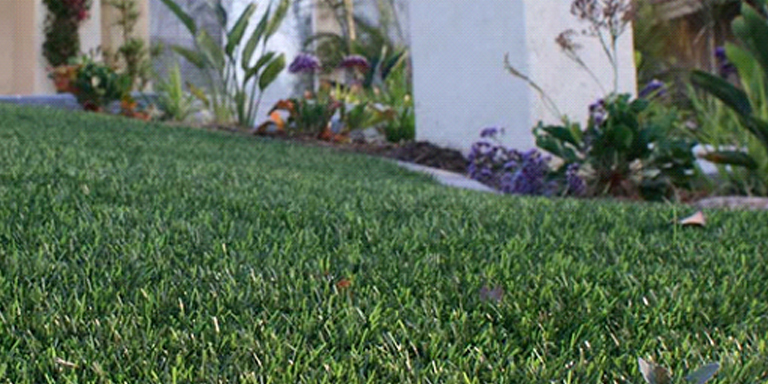Your cart is currently empty!
How to Treat Weeds in Artificial Grass and Pavers
Weeds are a bane for any type of lawn, with their ability to overtake the planned landscaping a true nightmare for homeowners.

Unfortunately for those homeowners choosing artificial grass or other types of pavers for landscaping, going artificial does not completely eliminate a weed infestation. While weeds may not grow as readily in artificial landscaping as they do in natural gardens, they are remarkably adaptable and tend to find a way to infiltrate no matter what type of landscaping method you choose. To help you curb weed growth, keep reading for 4 pro tips on how to treat weeds in artificial grass and pavers.

Be Proactive Prior to Installing Artificial Surface
It may sound cliché, but the best trick to prevent weeds from overtaking your artificial surface is to stop them before they start. Once weeds begin to take root and establish an environment hospitable for propagation, you face an uphill battle in keeping them under control.
Richard Callahan of El Paso Artificial Grass and Turf says “The best way to treat weeds is to prevent them from even growing. Before deciding to buy artificial grass/ turf, it is important to consider the type of environment you are in. Some weeds may grow faster in less dry environments which calls for more regular maintenance.”
As Callahan notes, it is critical to know your environment, determine which kind of weeds thrive in your area, and take preemptive measures to prevent the weeds from ever taking root.

For example, some weeds that typically thrive in damp, moist environments include knotweed, bindweed, moss, and creeping ivy. Therefore, if you live in a moist region where these types of weeds wreak havoc, you will want to consider some landscape drainage solutions that prevent water from absorbing into the artificial turf’s substrate and creating a moist environment hospitable to these weeds.
On the other hand, some weeds have adapted to thrive in dry, arid climates. Some examples include mustard weed, Russian thistle, and carpetweed. If you live in a dry environment where seeds for these weed types are prolific, you will actually want your artificial surface to be porous to allow for moisture into the soil substrate, as this will make the growing environment less than ideal for these weed types.

Secure the Perimeter Against Weed Contamination
No matter how diligently you work to prepare the area to be turfed, your chances for success are greatly undermined if the areas surrounding your artificial turf are littered with weeds. It will only be a matter of time before underground root connections and blowing seeds make their way into your carefully cultivated landscaping.
If the county is falling behind in maintaining the borrow ditches adjoining your property, you may have to get proactive and pull some weeds yourself. If you have an extended driveway that uses permeable pavers, regularly mow along the perimeter and dispose of the clippings so that errant seeds don’t blow onto your artificial turf. Spray any natural landscaping with a non-toxic solution to further keep weed growth in check.
Regularly Brush the Artificial Surface
While it is undoubtedly critical to protect the soil against weeds taking root, the majority of weed problems on artificial turf and pavers actually occur when weeds grow on top of the surface.
But aren’t artificial grass and pavers inorganic, thus prohibiting growth from occurring?
Yes, but soil deposits and plant debris that accumulate on top of the artificial surface actually provide enough bed for weed growth to occur. While these types of weeds will be flimsy and easy to remove, they are nonetheless unsightly when they start to sprout up.
Therefore, regularly brush artificial surfaces to remove any soil or organic buildup. A bi-weekly brush is usually sufficient, but once again, it is important to know your region and understand the conditions in which weeds can begin to sprout. Unfortunately, some of the most pesky breeds can arise in just a couple of days with little bed required, so more frequent brushing may be necessary.
Spray the Surface as Necessary
There is a bit of a stigma against spraying artificial surfaces, as some homeowners are afraid that it will introduce a toxic film that remains indefinitely, creating a dangerous environment for pets and children.
This does not have to be the case. Spraying the entire artificial surface once or twice a year will go a long way toward curtailing your weed problem, and there are many pet-safe, vinegar-based spray solutions that pose no risk of toxic contamination.
4 Pro Tips for Keeping Weeds Away from Artificial Grass and Pavers
Despite the many benefits of switching to artificial landscaping solutions, they are not a complete panacea against weeds. However, by being proactive prior to artificial turf installation, securing the perimeter of your landscaping against weed contamination, regularly brushing the artificial surface, and spraying the area as necessary, you can help prevent weed infiltration in any type of artificial grass or pavers.
Stephanie Rogers is a freelance writer that loves sharing her passion for writing with others. She lives in her hometown of Phoenix, Arizona where she enjoys spending time with her husband and dog and going on hikes. Stephanie’s work as a freelance writer can be found on Building Product Advisor, a new construction industry resource launching in Fall 2022.